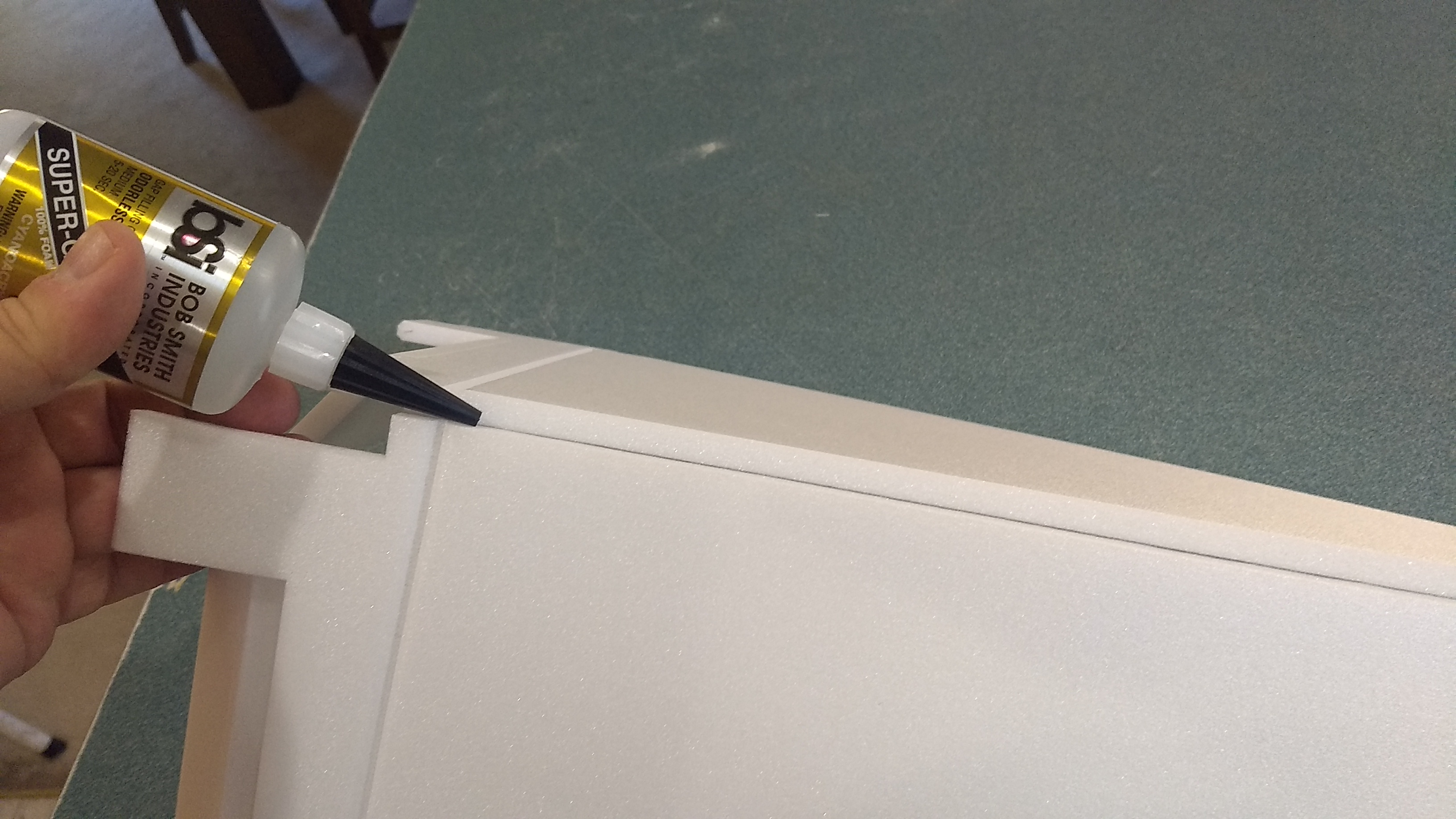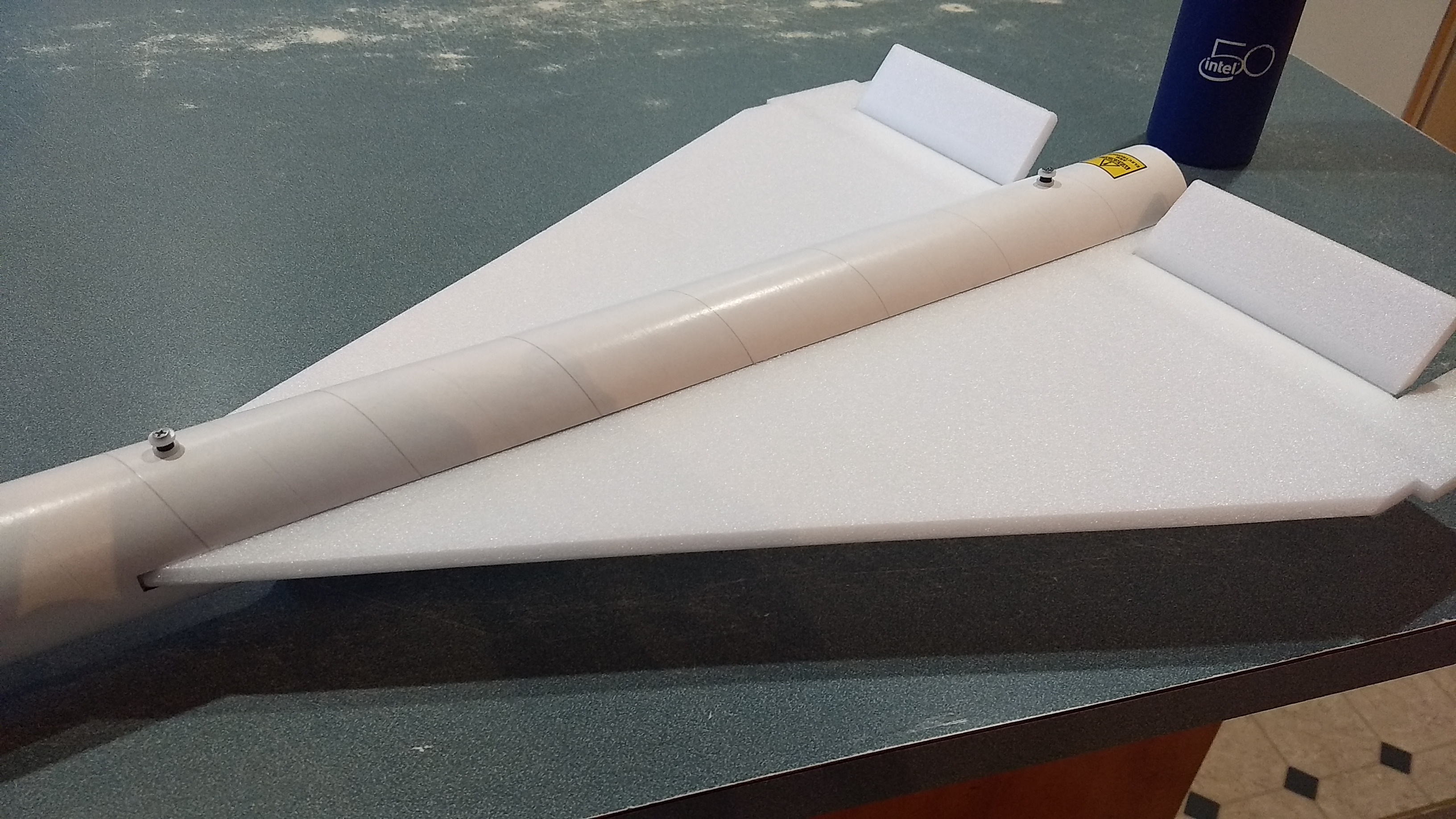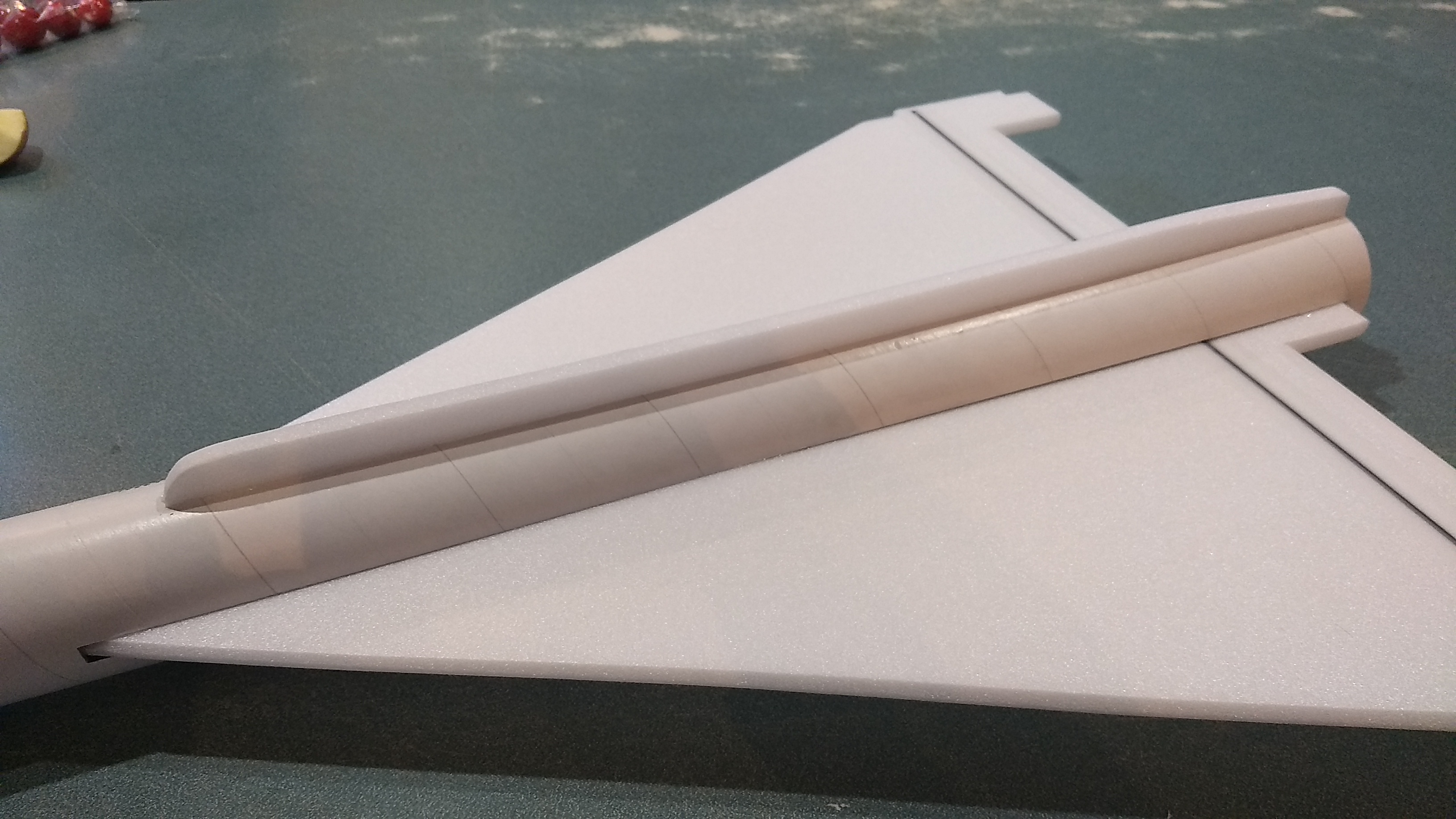
The Jayhawk RC Rocket glider kit is modeled after the Mach 4+ AQM-37 Jayhawk target drone. It features a clipped delta wing, and swept wingtips. It has a light wing loading giving it a very nice glide and easy/stable boost. It comes with a plastic nose cone, 2.6″ white tubing for the body and 9mm depron wing and tail surfaces. Construction is very simple and takes about an hour and a half. Elevons are pre-hinged, the rail buttons are pre-installed and the body tube is pre-slotted for the wing. The wing spar is pre-grooved for the spar. You will need two 10 gram type servos, two 16″-18″ servo extensions, a receiver, and a small 500mah single cell lipo battery. You will need a transmitter with delta or elevon mixing. Length 37″, wingspan 20″, weight rtf 11.75-12 oz. Decals are available HERE
CG location for rocket flight: 13.5″ forward of the rear end of the body tube.
Identify all pieces, the kit should contain:
1 wing taped together
1 Motor mount
1 Nose Cone
1 wing spar(carbon fiber)
1 Foam Conduit/Keel
1 coupler
2 Body Tubes
2 wingtips
2 canards
2 control horns/Pushrods
2 motor mount centering strips, 6mm by 2.75″
Velcro(for battery and rx/bec attachment)
3M blenderm tape
Lead weight
Spare depron
Notes before starting:
Reference to CA+ means foam safe CA+, normal CA+ will melt the foam! Normally you need to use accelerator to get the CA to set on the foam since there is nothing for it to soak into and activate.
Epoxy is not needed in this model. Weight is critical and the model is designed for the thrust and flight loads. Weight in the rear end is bad and will require additional weight in the front of the model.
Assembly:
- There is a wrap on the main body tube to help hold it’s shape, once the slot is cut it wants to flatten, leave that in place till you are ready to insert the wing, then remove it.
- Glue the two centering strips on the motor mount on the two lines that are opposite each other. See Photo.
- Unfold the wing and glue the joint using CA+ and accelerator, make sure it is flat.
- Glue the wing spar in the pre-slotted area on the bottom of the wing with CA+ and then tape over the spar and wing joint with the included blenderm tape.
- Install the rail buttons in the pre-made holes at this time.
- Test fit the wing in the slot in the rear body tube, if it is snug, sand or trim as you don’t want it to drag/damage the wing as you are inserting it. Note the rail buttons are on the top of the model and the holes will be pointing up, the visible spar will be down on the wing.
- Insert the coupler in the rear of the body tube till it hits the wing. Inserting it helps to keep the rear of the body tube round and helps in centering the wing. Tack glue the rear making sure not to glue the coupler in place.
- Remove the coupler and insert it in a similar way in the front of the tube. Make sure the wing is centered at the front and tack glue in place at the front being careful not to glue the coupler in place, then remove the coupler and glue the wing on the and bottom with foam safe CA+. It may be helpful to squeeze the tube in the middle as you go as the tube tends to flatten once the wing slot has been cut.
- Test fit the motor tube in the rear of the model, You may need to sand the foam tabs slightly till it will insert easily. The tabs will be vertical and the sides will be centered by the recess in the wing. Run glue on the top and bottom motor mount tabs to glue them to the body tube. You don’t need a lot of glue here as the motor pushes against the rear of the wing which is glued in its’ slot so it can’t really go anywhere.
- Glue the coupler into the front of the tube until it stops against the rail button t-nut.
- Glue the short forward body tube onto the coupler, there is a small alignment mark on the bottom to make sure the pieces are aligned, these tubes are cut by hand so aligning the mark makes sure the joint has no gaps.
- Glue the keel onto the bottom of the body tube using the alignment line as a guide. The rear of the keel(the flat end) is flush with the rear of the body tube.
- Test fit and trim then glue the two wing tips to the wing using the tabs/slots. The shorter portion points down to have clearance on landing. Make sure they are perpendicular to the wing, and the pre-cut angle cuts on the leading edges are on the outside.
- Glue the control horns in place on the bottom of the control surfaces, the holes face forward and the pushrod should be closest to the body tube.
- Test fit then glue the canards in the slots in the nose cone, use the wings as an alignment guide to make sure the canards don’t droop while the glue dries.
The basic construction is now complete.
Radio Installation
Note: Your radio needs to be configured for Delta mixing, this means that the servo arms will move the same direction during elevator stick movement and opposite for aileron stick movement. Connect your servos to the receiver one in the aileron connection and one on the elevator connection and apply power. Use a servo arm at least 9/16” long and with holes small enough that there won’t be slop with the pushrod wire when installed. I use the hole furthest out on the servo arm, to maximize movement. On some servos there are a long two-ended servo arm, you can trim off one end if needed to get sufficient length. Zero out any trim settings on the transmitter. The model once the motor has burned out is nose heavy and flying wings lose pitch authority when nose heavy so you want as much up elevator travel for trim/flare as possible.
- Connect a servo to each pushrod. If the pushrod is too tight, you can use twist an exacto knife in the servo arm hole to make it larger, but be careful and do not make it too large. Once connected, tape each servo in place so that the control surfaces are centered. Flip the model right side up and look at it from the rear. Moving the transmitter stick back(up elevator) should move both elevons up. Moving the transmitter stick to the right should move the right elevon up and the left elevon down. If you can’t get the servo reversing to give you the right polarity try swapping aileron/elevator inputs to the receiver or turning the servos over and swapping the servo arms to the other side of the output shaft. If that is correct, continue.
- Flip the model upside down and supported. The servos may be attached to the model using double back servo mounting tape(not included) or by directly gluing the servo to the wing with CA+ or a small amount of epoxy. Double back servo tape can loosen over time and with exposure to heat, I prefer to glue the servo in place. With the radio still on, put a small amount of glue on the servo, being careful not to get any near the output shaft. And set it in place on the model keeping the control surface centered. Do the same to the other side. Make sure the glue is set before continuing. The servo and pushrod should be at 90 degrees to the hinge line so that it moves easily and fully.
- Flip the model back right side up. Make sure the control surfaces are centered, use trims if needed. Now measure the control surface movement. Full elevator movement should be 1” in each direction, aileron movement should be 1/2″ in either direction. Since the model will be nose heavy, extra elevon movement helps to give sufficient authority during glide.
- If you have a flap/elevator mix you can program up elevator to a switch setting. The model needs approximately 3/16″ to1/4” of up elevon during glide. If you can’t set the up elevator trim to a switch on your radio you’ll have to manually put in boost and glide trim which is hard to do while flying the model.
- Attach a 16-18″ servo extension to each servo.You just need to be able to route the wire to the front of the tube to attach it to the receiver.
- Make a 1/8″ wide by 1/2″ long slot in the bottom of the wing/fuselage on each side and pass the wires through to the inside and toward the front. On my model I just made a U shaped cut, folded the cardboard forward, inserted the wire then folded the cardboard back over the slot/wire. I then taped over that with blenderm tape to avoid having a large open slot. See photo for more clarity. You can also just cut the slot out completely and cover it over with tape after inserting the wire.
- Attach the servo wires to the receiver and make sure they are going the right direction. Tape over the slots in the body tube.
- Use the included Velcro to attach the receiver inside the front of the body tube recessed enough to clear the nose cone shoulder.
- Use the included velcro to attach the battery inside the shoulder of the nose cone, it may be desirable to wait to place the velcro to see how the balance is, I was able to avoid nose weight by simply moving the battery slightly by an inch or two.
- If you paint the model, make sure you test it on scrap foam first.
- If you are going to paint the model, you can mask off the servos. Make sure no paint will get on the servo output arm. I only use Model Master(testors) or testors enamel small rattle cans for painting directly on the foam and cannot recommend any others as you may melt the foam. Do not spray too close or too thick as the solvents can damage the foam, spray in light coats.
- I used flat black and flat red testors rattle can paint. I then used decals from Stickershock23 to finish it. With the vinyl from stickershock23 it helps once applied to use a hair dryer on hot to soften the material and then push it down onto the model with a towel. It helps it confirm and stick much better, especially on painted surfaces.
- Insert your heaviest loaded rocket motor into the motor mount
- Support the model at the balance point indicated for boost. I use two pencils with the eraser pointed up and held in place with a small hand vice. Place the model upside down on the pencil erasers on the balance point indicated in the kit spec sheet. Use the included lead weight to balance it. Do not try to fly the model with it balancing it behind this point. The adage is, a nose heavy model flies poorly, a tail heavy model flies once. Make sure you do this after you painted your model as this will add tail weight.
Flying: See the General Instruction/Information link at the top for flying instructions. Be ready on the first few flights to keep the model straight till you have the trims set perfectly for boost and glide.
- Glue the two thin foam strips on the motor tube on the two lines that are opposite each other
- Glue the wing center joint
- Lay the wing flat till the glue dries
- Glue the spar
- Tape over the spar and center joint
- Insert coupler in the rear of the body tube to help hold the tube round which will help in centering the wing before gluing. Note the rail buttons are facing up.
- Glue the wing when centered and remove the coupler.
- Test fit and then glue the motor mount in the rear of the model, note it is inset about 1/2″
- glue the coupler into the rear tube then add the forward tube aligning the arrow marks on the bottom of the tubes.
- Glue the conduit on the bottom of the model.
- Glue on the wingtips.
- Glue the control horns into the pre-made holes on the bottom of each control surface, note the pushrod is closest to the body tube.
- Install the servos
- cut slots in the body tube and route the servo wires forward, then cover over the slots.
- Attach the receiver into the forward part of the body tube back far enough to clear the nose cone shoulder using velcro, the battery can be in the body or nose cone as needed for CG to avoid adding weight.
- Model painted
- Completed model with stickershock markings.
















